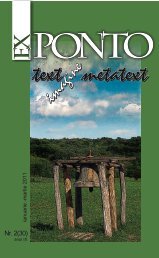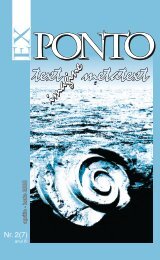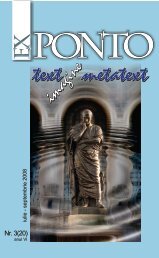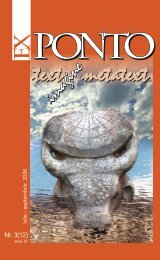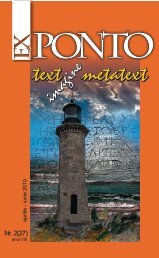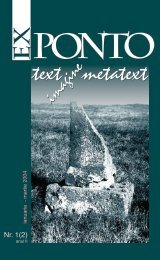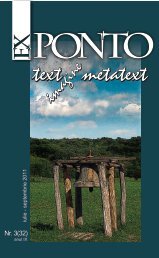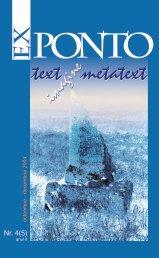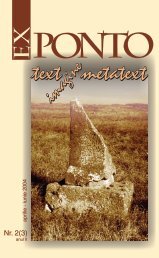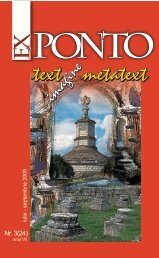Nr. 2 (19) anul VI / aprilie-iunie 2008 - ROMDIDAC
Nr. 2 (19) anul VI / aprilie-iunie 2008 - ROMDIDAC
Nr. 2 (19) anul VI / aprilie-iunie 2008 - ROMDIDAC
You also want an ePaper? Increase the reach of your titles
YUMPU automatically turns print PDFs into web optimized ePapers that Google loves.
aspecte ale imaginii<br />
ILEANA MARIN<br />
University of Washington, Seattle<br />
Paradoxes of ideological constrains<br />
B<br />
etween <strong>19</strong>48 and <strong>19</strong>89 Romania underwent several stages of communism,<br />
from the darkest pro-soviet era of the 50s to the final stage of total<br />
deprecation of life conditions and the denial of human rights and freedom<br />
of the late 80s. In terms of the ideological pressure on literature and arts<br />
the communist regime may be divided into four periods: the period of<br />
sovietization dominated by Socialist Realism (<strong>19</strong>48 – <strong>19</strong>58); the period<br />
of rehabilitation of Romanian values and liberal reform with an immediate<br />
consequence in a larger spectrum of artistic experiments (<strong>19</strong>59-<strong>19</strong>71);<br />
the Romanian version of the Maoist “cultural revolution” characterized<br />
by a presumably ideologically correct discourse which, at the same time,<br />
created the possibility of subversive meanings (<strong>19</strong>71-81); and the most<br />
severely controlling period dominated by the cult of Ceausescu when the<br />
stylistic icing/coating of the inconvenient meanings became the norm of<br />
Romanian literature and arts. The public art and the published literature<br />
had to fit into the limitations imposed by censorship. The most aggressive<br />
forms of censorship were in the first and the last period when artists and<br />
authors risked literally their life not only by losing their income or their<br />
freedom, but also by suffering an “accidental” death.<br />
Romanian authorities succeeded in spreading the fear of censorship so<br />
that Romanian artists and writers began to develop an elaborate strategy<br />
of self-censorship in order to avoid confronting the Second Cabinet,<br />
famous for its brutal measures against intellectuals generally, and writers<br />
and artists specifically. 1 Under these circumstances self-censorship was a<br />
solution for survival not only for those engaged in public art, but also for all<br />
Romanians whenever they spoke publicly. Self-censorship was embedded<br />
in everybody’s consciousness despite profession, social position, income,<br />
and/or rank in the communist party hierarchy. Ion Negoitescu 2 considered<br />
self-censorship “more dangerous than censorship itself, because it can<br />
struggle free from the writer’s critical mind and act subconsciously,<br />
falsifying the message” (<strong>19</strong>). He himself chose not to publish during the<br />
Stalinist epoch and later on, misunderstanding the ideological signals at<br />
the end of the 50s when he began to publish again he was accused of<br />
“aestheticism” and sentenced to three years in jail at Jilava. Although it<br />
Ex Ponto nr.2, <strong>2008</strong><br />
161




